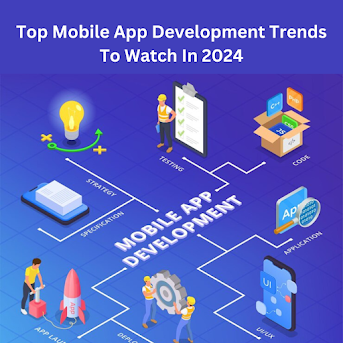Top Mobile App Development Trends to Follow in 2024
The mobile app development landscape is in constant flux, driven by technological advancements, changing user expectations, and the relentless pace of innovation. As we move into 2024, the trends shaping this industry are set to redefine how businesses engage with customers, streamline operations, and leverage the power of mobile technology. In this blog, we'll explore the top mobile app development trends to watch in 2024.
1. Artificial Intelligence and Machine Learning Integration
Artificial Intelligence (AI) and Machine Learning (ML) have been transformative forces in mobile app development over the past few years, and 2024 will see these technologies becoming even more integral. AI-powered chatbots, personalized recommendations, voice assistants, and image recognition are just the beginning.
In 2024, we can expect AI and ML to evolve further, enabling apps to learn from user interactions and predict their needs more accurately. For instance, AI can help e-commerce apps to offer personalized shopping experiences by analyzing users' browsing and purchasing patterns. In the healthcare sector, AI-driven apps can assist in diagnosing conditions based on symptoms input by the user or even data from wearable devices.
Additionally, AI is set to play a critical role in enhancing app security. ML algorithms can detect unusual patterns of behavior, such as unauthorized access attempts, and take proactive measures to safeguard user data.
2. 5G Technology Revolution
The rollout of 5G networks worldwide is set to revolutionize mobile app development. With speeds up to 100 times faster than 4G, 5G technology will enable more complex, data-intensive apps to operate seamlessly on mobile devices.
For developers, this means fewer concerns about latency and the ability to create richer, more immersive experiences. For instance, augmented reality (AR) and virtual reality (VR) apps, which require high bandwidth and low latency, will become more common and practical. Gaming apps will also benefit from 5G, offering console-quality graphics and gameplay on mobile devices without the need for heavy processing power.
In 2024, the full potential of 5G will start to be realized, with more apps taking advantage of its capabilities to offer features that were previously impossible or impractical.
3. Augmented Reality (AR) and Virtual Reality (VR)
AR and VR technologies have been gaining traction in mobile app development, and 2024 will see these technologies being adopted across various industries. With the rise of 5G, AR and VR apps will deliver even more seamless and interactive experiences.
Retailers are increasingly using AR to offer virtual try-on experiences for clothes and accessories, allowing users to see how products will look before purchasing. In the education sector, AR and VR are being used to create immersive learning environments that make complex subjects more accessible and engaging.
As hardware continues to improve and become more affordable, we can expect AR and VR to become mainstream in mobile apps, offering users experiences that blend the digital and physical worlds in unprecedented ways.
4. Super Apps: The One-Stop Solution
Super apps, which combine multiple services into a single platform, are set to become more popular in 2024. Originating in Asia, super apps like WeChat and Gojek offer users a wide range of services, from messaging and social networking to payments, shopping, and ride-hailing, all within one app.
The appeal of super apps lies in their convenience. Users no longer need to switch between multiple apps to perform different tasks; instead, they can access all the services they need from a single interface. For businesses, super apps offer opportunities to capture and retain users by providing a more integrated and comprehensive user experience.
In 2024, we can expect more companies, especially in Western markets, to explore the development of super apps or the integration of multiple services within their existing apps.
5. Progressive Web Apps (PWAs)
Progressive Web Apps (PWAs) have been around for a while, but they continue to gain popularity due to their ability to offer a native app-like experience on the web. PWAs are web applications that can be accessed via a browser but offer offline functionality, push notifications, and other features typically associated with native apps.
In 2024, PWAs will become even more sophisticated, offering faster loading times, improved user experiences, and greater security. Businesses are increasingly adopting PWAs as they provide a cost-effective alternative to native apps, with the added advantage of being accessible across all devices without the need for separate development for different platforms.
For users, PWAs offer the convenience of not having to download and install an app, making them an attractive option for businesses looking to reach a broader audience.
6. Blockchain Technology
Blockchain technology is no longer limited to cryptocurrencies; it is increasingly being used in mobile app development to enhance security, transparency, and traceability. In 2024, blockchain is expected to play a more significant role in sectors like finance, supply chain management, and healthcare.
For instance, mobile payment apps can use blockchain to offer more secure and transparent transactions, reducing the risk of fraud. In supply chain management, blockchain-based apps can provide real-time tracking of goods, ensuring that all parties involved have access to accurate and up-to-date information.
Blockchain's decentralized nature also makes it an attractive option for apps that require a high level of security, such as those dealing with sensitive user data or financial transactions.
Conclusion
The mobile app development landscape in 2024 is set to be more dynamic and innovative than ever before. As technologies like AI, 5G, AR, VR, and blockchain continue to evolve, they will open up new possibilities for developers and businesses alike. Staying ahead of these trends will be crucial for anyone looking to succeed in the highly competitive mobile app market. By embracing these trends, businesses can create apps that not only meet but exceed user expectations, offering richer, more personalized, and secure experiences.

Comments
Post a Comment